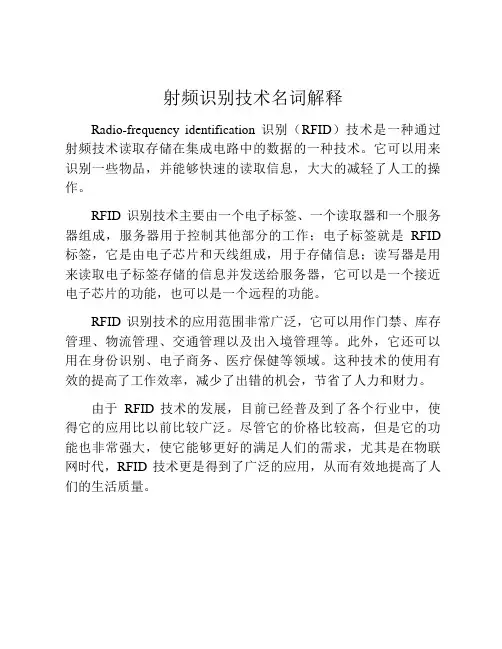radio-frequency-identification
- 格式:pdf
- 大小:71.04 KB
- 文档页数:17

rfid原理RFID原理。
RFID(Radio Frequency Identification)是一种无线通信技术,通过无线电频率识别目标并读写相关数据。
它主要由标签、读写器和数据处理系统组成。
标签是RFID系统的核心部件,它包括芯片和天线,用于存储和传输信息;读写器用于与标签进行通信,并将读取的信息传输到数据处理系统进行处理。
RFID技术已经被广泛应用于物流、仓储、零售、交通、医疗等领域,其原理和工作方式对于我们了解现代物联网技术有着重要的意义。
RFID技术主要包含以下几个方面的原理:1. 无线通信原理。
RFID技术利用无线电频率进行通信,其工作原理类似于无线电波的传输。
当读写器向标签发送激活信号时,标签接收到信号后会被激活,并开始与读写器进行通信。
在通信过程中,读写器会向标签发送指令,并读取标签存储的信息。
这种无线通信的原理使得RFID技术可以实现非接触式的数据传输,大大提高了数据采集的效率和便利性。
2. 芯片和天线原理。
RFID标签的芯片和天线是实现数据存储和传输的关键部件。
芯片内部包含存储器和处理器,用于存储和处理标签的信息。
天线则用于接收和发送无线电信号,实现与读写器的通信。
当读写器向标签发送激活信号时,天线会接收到信号并激活芯片,然后进行数据的读写操作。
芯片和天线的设计和制造对于RFID技术的性能和稳定性有着重要的影响。
3. 数据处理原理。
RFID技术的数据处理主要包括数据的读取、存储和传输。
当读写器与标签进行通信时,读写器会向标签发送读取指令,标签接收到指令后会将存储的信息通过天线发送给读写器。
读写器接收到信息后会将数据传输到数据处理系统进行处理和存储。
数据处理系统可以对接收到的数据进行分析和管理,实现对物品的追踪和管理。
4. 工作频率和识别距离原理。
RFID技术可以工作在不同的频率下,包括低频、高频和超高频。
不同频率的RFID系统具有不同的识别距离和通信速率。
低频RFID系统通常具有较短的识别距离,适用于近距离识别和数据传输;高频和超高频RFID系统具有较远的识别距离,适用于远距离识别和大规模数据采集。

射频识别技术名词解释
Radio-frequency identification 识别(RFID)技术是一种通过射频技术读取存储在集成电路中的数据的一种技术。
它可以用来识别一些物品,并能够快速的读取信息,大大的减轻了人工的操作。
RFID识别技术主要由一个电子标签、一个读取器和一个服务器组成,服务器用于控制其他部分的工作;电子标签就是RFID 标签,它是由电子芯片和天线组成,用于存储信息;读写器是用来读取电子标签存储的信息并发送给服务器,它可以是一个接近电子芯片的功能,也可以是一个远程的功能。
RFID识别技术的应用范围非常广泛,它可以用作门禁、库存管理、物流管理、交通管理以及出入境管理等。
此外,它还可以用在身份识别、电子商务、医疗保健等领域。
这种技术的使用有效的提高了工作效率,减少了出错的机会,节省了人力和财力。
由于RFID技术的发展,目前已经普及到了各个行业中,使得它的应用比以前比较广泛。
尽管它的价格比较高,但是它的功能也非常强大,使它能够更好的满足人们的需求,尤其是在物联网时代,RFID技术更是得到了广泛的应用,从而有效地提高了人们的生活质量。

rfid定位原理RFID(Radio Frequency Identification)定位原理是通过使用无线电频率识别技术,对环境中的RFID标签进行读取和识别,从而实现对物体的定位和跟踪。
其原理如下:1. RFID标签:RFID标签由芯片和天线组成。
芯片中包含了标签的唯一识别码和存储器,用于存储物体的相关信息。
天线则用于接收和发送无线电信号。
2. RFID读写器:RFID读写器通过发送无线电信号来激活附近的RFID标签,并接收标签返回的信号。
读写器可以连接到网络或计算机上,将读取到的标签信息传输给系统进行处理。
3. 电磁感应:RFID读写器发射的无线电信号会激活标签中的电路,使其开始工作。
标签会接收到读写器发射的能量并利用其进行工作。
4. 识别码:每个RFID标签都有一个唯一的识别码,根据该识别码可以对每个标签进行区分和识别。
读写器读取到的识别码会传输到系统中,系统根据这些识别码进行物体的定位和跟踪。
5. 读取数据:一旦RFID标签被激活,它会将存储在芯片中的信息通过无线电信号返回给读写器进行读取。
读写器接收到这些数据后会将其传输到系统上,系统可以根据这些数据进行相应的操作。
6. 范围限制:RFID定位的有效范围取决于读写器和标签之间的距离。
一般情况下,读写器与标签之间的距离越远,识别和读取的效果就越差。
总结起来,RFID定位原理是通过无线电识别技术实现对RFID标签的读取和识别,进而实现对物体的定位和跟踪。
读写器通过发送激活信号激活标签,标签接收到信号后返回存储在芯片中的信息,读写器将这些信息传输到系统进行进一步处理。

RFID的功能是什么无线射频识别技术(Radio-Frequency Identification,简称RFID)是一种通过无线通信进行数据传输的技术。
RFID系统由读写器和标签两部分组成。
标签内置有芯片和天线,读写器通过无线通信方式可以读取或写入标签中的信息。
RFID的主要功能1.识别和追踪物品RFID技术可以用于识别和跟踪具有标签的物品。
标签可以贴在物品上,在生产、仓储、物流等环节中,通过读写器扫描标签,可以快速准确地识别物品,实现自动化的物品追踪管理。
2.访问控制和身份识别RFID技术可以用于门禁系统、车辆管理系统等方面。
通过携带RFID标签的用户或车辆,在经过RFID读写器时可以实现自动的身份验证,提高安全性并简化管理流程。
3.支付和交易RFID技术也被广泛应用于无现金支付系统中。
用户持有带有RFID标签的支付卡,可以通过近距离无线通信完成支付交易,提高支付效率和便利性。
4.库存管理和防盗系统在商场、图书馆等场所,RFID标签可以帮助实现库存管理和防盗功能。
商场可以通过RFID技术更精确地掌握库存情况,减少库存积压,同时还能避免窃贼通过携带未付款商品离开。
5.环境监测与实时定位RFID技术还可以应用于环境监测和实时定位领域。
通过在物体或环境中标记RFID标签,并在区域内部署读写器,可以实时监测物体的位置和状态,为实时定位、追踪提供了技术支持。
总结RFID技术的功能多样化,涵盖了物品识别追踪、身份识别、支付交易、库存管理、环境监测等多个领域。
随着技术不断发展,RFID在未来将应用得更加广泛,为各行业提供更便捷、高效的解决方案。

RFID识别原理
RFID(Radio Frequency Identification)识别原理是通过无线电
频率信号实现物体识别和跟踪的技术。
它基于无线电波与芯片之间的相互作用,将信息从读取器传输到标签上,以实现物体的识别。
RFID系统由三个主要部件组成:读取器(也称为读写器、扫
描器)、RFID标签(也称为电子标签、智能标签)和信息系统。
读取器通过发送具有特定频率和功率的无线电信号,激活附近的RFID标签。
标签接收信号并反馈有关其身份或特定数
据的信息。
读取器通过天线收集标签反馈的信号并解码其中的信息。
最后,信息系统将识别到的数据进行记录、处理和管理。
RFID标签包含一个RFID芯片和一个天线。
芯片中存储了关
于物体的标识符、存储器或其他特定数据。
天线用于接收和发送无线电信号。
RFID识别过程主要涉及以下几个步骤:
1. 激活:读取器发送无线电信号以激活标签。
2. 反馈:激活的标签将接收到的信号通过天线反馈给读取器。
3. 读取器接收:读取器通过天线接收到标签反馈的信号。
4. 解码:读取器解码接收到的信号,获取标签中存储的信息。
5. 数据处理:获取的信息可通过信息系统进行处理,如记录、验证或控制。
6. 数据应用:识别到的数据可应用于物流、库存管理、访问控制、支付系统等各种应用领域。
RFID识别具有许多优点,如高效率、非接触式、可自动化、抗干扰能力强等。
它被广泛应用于供应链管理、物流追踪、资产管理、电子支付、智能门禁等领域。

无线射频识别技术名词解释
无线射频识别技术(Radio Frequency Identification,简称RFID)是一种利用无线电波进行非接触式自动识别的技术。
通过内置或粘贴电子标签,物品能够被自动识别,无需人工干预。
RFID技术广泛应用于物流、供应链管理、零售、制造、医疗、交通等众多领域,极大地提高了工作效率和准确性。
在RFID系统中,电子标签附着在待识别的物品上,包含有存储信息的芯片和天线。
电子标签通过与RFID读写器之间的无线通信进行信息交换。
当RFID读写器发出的无线电波覆盖范围内,电子标签能够接收信号并从中获取能量,从而实现非接触式通信。
RFID读写器负责发送无线电波并接收来自电子标签的信号。
根据应用需求,RFID读写器可以是固定式或手持式,可以同时读取多个电子标签,大大提高了识别速度和效率。
RFID技术的优势在于非接触式识别、快速批量识别、环境适应性强等特点。
同时,RFID技术能够实现物品的实时跟踪和追溯,提高了供应链的透明度和可控性。
随着物联网技术的不断发展,RFID技术将在更多领域发挥重要作用。

射频识别的工作原理《射频识别的工作原理》射频识别(Radio Frequency Identification,RFID)是一种用于自动识别物体的技术。
它通过在物体上植入或附近放置一个微型电子标签,利用无线射频信号实现数据的传输与识别。
在近年来的物联网时代,RFID得到了广泛的应用,被用于零售、物流、农业、交通等领域。
射频识别的工作原理主要涉及三个主要组成部分:射频标签、读写器和后端系统。
1. 射频标签:射频标签由射频芯片和一种塑料或纸质外壳组成。
射频芯片一般由一个微处理器、存储器和天线构成。
当标签靠近读写器时,读写器会通过无线射频信号向标签发送电能,使射频标签激活。
2. 读写器:读写器是射频识别系统的设备之一,用于激活和读取射频标签上存储的数据。
读写器可以通过射频信号与标签进行通信,传输读取到的数据到后端系统进行处理。
读写器一般由射频发送器、射频接收器、控制器和通信接口组成。
3. 后端系统:后端系统用于处理来自读写器的数据,并进行进一步的分析和应用。
这些数据可以用于库存管理、资产跟踪、防伪识别等应用场景。
后端系统一般由数据库和相应的软件算法组成,它们将读取到的射频标签数据与其他数据进行关联和比对。
射频识别的工作过程如下:1. 激活标签:当一张射频标签靠近读写器时,读写器会向标签发送射频信号,为标签提供电能。
标签通过接收射频信号的能量来激活,并开始与读写器进行通信。
2. 数据传输:一旦射频标签激活,它将会向读写器发送存储在芯片内的数据。
这些数据可以是产品的相关信息,如批次号、生产日期等。
读写器通过射频信号收集标签发送的数据,并将其传输到后端系统进行处理。
3. 数据处理与应用:在后端系统中,读取到的射频标签数据会被与其他相关数据进行比对和关联。
通过这个过程,后端系统可以实现库存管理、资产跟踪等应用功能。
总之,射频识别是一种通过射频信号实现自动识别物体的技术。
通过射频标签、读写器和后端系统的配合,射频识别可以实现数据的传输和处理,为各行业提供了方便、高效的自动识别解决方案。

了解射频识别技术的基本原理和工作原理射频识别技术(Radio Frequency Identification,简称RFID)是一种通过无线电信号实现物体自动识别的技术。
它可以用于物品的追踪、管理和控制,广泛应用于物流、供应链管理、交通运输、零售业等领域。
本文将介绍射频识别技术的基本原理和工作原理。
一、射频识别技术的基本原理射频识别技术基于无线电通信原理,将物体与射频标签联系起来,通过射频信号的传输和接收,实现对物体的识别和追踪。
射频识别系统由三个主要组成部分构成:射频标签、读写器和中央数据库。
1. 射频标签:射频标签是射频识别系统中的被识别物体的载体。
它由射频芯片和天线组成。
射频芯片储存了与被识别物体相关的信息,如物品的序列号、生产日期等。
天线用于接收和发送射频信号。
2. 读写器:读写器是射频识别系统中的核心设备,用于与射频标签进行通信。
读写器通过射频信号与射频标签进行数据交换,读取射频标签中的信息。
读写器还可以向射频标签写入新的数据。
3. 中央数据库:中央数据库是射频识别系统中存储和管理射频标签信息的地方。
读写器将读取到的射频标签信息传输到中央数据库中,用户可以通过查询数据库获取所需信息。
二、射频识别技术的工作原理射频识别技术的工作原理可以简单概括为:读写器向射频标签发送射频信号,射频标签接收到信号后,将储存在芯片中的信息通过射频信号传回给读写器,读写器再将信息传输到中央数据库进行处理和存储。
具体来说,射频识别技术的工作过程包括以下几个步骤:1. 初始化:读写器向射频标签发送初始化信号,激活射频标签。
2. 识别:读写器向射频标签发送识别信号,射频标签接收到信号后,将储存在芯片中的信息通过射频信号传回给读写器。
3. 数据处理:读写器将接收到的射频标签信息传输到中央数据库进行处理和存储。
中央数据库可以对接收到的信息进行分析、查询和管理。
4. 反馈:根据中央数据库的处理结果,读写器可以向射频标签发送反馈信号,如写入新的数据或修改标签状态。

rfid组成结构RFID,即Radio-Frequency Identification,射频识别技术,是一种通过射频信号来识别物体的技术。
RFID由三个主要部分组成:标签(Tag)、读写器(Reader)和数据处理系统(Data Processing System)。
首先,让我们从标签开始讨论。
标签是RFID系统中最基本的组成部分之一。
它是一个小型设备,可以将其附加到物体上,以便在RFID系统中进行识别。
标签通常包含一个芯片和一个天线。
芯片储存了物体的相关信息,而天线则用于与读写器之间进行通信。
标签可以分为被动型和主动型。
被动型标签依赖读写器发送的无线电能量来激活,并将存储的信息回传给读写器。
主动型标签则具有自己的电池,可以主动地向读写器发送信息。
接下来是读写器,它是RFID系统的核心部分之一。
读写器使用无线电频率与标签进行通信,并读取或写入标签上的信息。
读写器通常由射频模块、控制器和接口等组成。
射频模块负责发射射频信号并接收标签的回应信号。
控制器则对射频模块进行控制,并处理读写器与数据处理系统之间的通信。
接口则用于与外部设备(如计算机)进行连接,以便将读取的信息传递给数据处理系统。
数据处理系统是RFID系统中的第三个组成部分,它主要负责处理读写器中收集到的数据。
数据处理系统通常包含有数据库、应用程序和用户界面等。
数据库用于存储和管理从标签中读取的信息。
应用程序则负责处理和分析数据,并根据需要执行相应的操作。
用户界面则向用户展示信息,并允许用户与系统进行交互。
除了这三个主要组成部分之外,RFID系统还涉及一些其他关键技术。
其中包括射频识别技术、数据传输协议、安全性和隐私保护等。
射频识别技术是RFID系统的核心技术,它使用无线电信号进行标签的识别和通信。
数据传输协议定义了标签和读写器之间进行通信的规则和格式。
安全性和隐私保护是RFID系统中非常重要的考虑因素,它们确保只有授权的用户能够访问和使用标签上的信息。

rfid射频识别技术基本工作原理RFID(Radio-Frequency Identification)技术是一种无线射频识别技术,广泛应用于物联网、供应链管理、物流跟踪、智能交通等领域。
其基本工作原理是利用射频信号进行物品识别和数据传输。
本文将对RFID技术的基本工作原理、应用领域以及发展趋势进行介绍。
一、RFID技术的基本工作原理RFID技术的基本工作原理是由读写器(Reader)和标签(Tag)组成的系统。
读写器通过天线发射射频信号,当该信号接收到标签天线上时激活标签。
标签接收到射频信号后,利用这个能量驱动自身的芯片,将存储在芯片内的信息回传给读写器,完成数据的读取和写入。
整个过程无需接触,可实现远程自动识别。
RFID系统包括以下几个主要组成部分:1.标签天线:用于接收来自读写器的射频信号,并传递给标签芯片。
2.标签芯片:内嵌有芯片和天线的标签,用于存储物品信息并与读写器进行通信。
3.读写器天线:用于发射射频信号,并接收标签回传的射频信号。
4.读写器模块:负责发射射频信号、接收标签回传信号、数据处理和通信。
5.控制系统:管理整个RFID系统的数据读写、信息处理和设备控制。
二、RFID技术的应用领域1.物流管理:在物流管理领域,RFID技术可以实现对货物的追踪和管理。
标签可以贴附在货物上,通过RFID读写器对货物进行自动识别和记录,提高了物流管理的效率和精度。
2.供应链管理:RFID技术可以帮助企业对供应链进行实时监控和管理,提高生产和物流的效率,降低库存成本,改善供应链整体运作效果,实现供需匹配。
3.零售业:在零售业中,RFID技术可以用于商品的防盗和库存管理。
通过RFID标签的贴附,能够实现对商品的追踪和定位,提高了商品管理的便捷性和精准性。
4.医疗保健:在医疗保健领域,RFID技术可以用于病人身份识别、药品管理、设备追踪等方面,提高了医疗保健服务的精准性和效率。
5.智能交通:RFID技术可以应用于智能交通领域,如收费系统、车辆管理、车辆定位等方面,提高了智能交通系统的管理和服务水平。

RFID的工作原理与基本流程无线射频识别技术(Radio-Frequency Identification,RFID)是一种无线通信技术,用于自动识别目标物体的标识,并将数据传输到相关系统。
RFID系统由读写器和标签组成,其工作原理比较简单,但应用广泛,包括物流管理、门禁系统等领域。
RFID的工作原理RFID系统的工作基础是电磁感应原理。
读写器发射无线电频信号,当这些信号与靠近的RFID标签中的电路产生感应时,标签中的芯片就会激发起来。
标签接收并解释读取器发送的信号,然后将其内部存储的信息发送回读取器。
这种信息可以是唯一的标识符或更复杂的数据。
RFID的基本流程1.发送请求–读写器向附近的RFID标签发送请求。
2.标签回应–RFID标签收到请求后,会回应读写器,通常包括其唯一标识符等信息。
3.数据传输–读写器接收到标签的响应后,可以读取标签携带的信息,并将其传输到相关系统进行处理。
4.系统响应–相关系统接收到标签传输的数据后,可以根据需要做出相应的处理,比如更新库存信息、记录出入时间等。
RFID的应用领域RFID技术在现代社会中的应用非常广泛,其中主要包括以下几个领域: - 物流管理:利用RFID技术可以实现物流信息的追踪、管理和控制,提高仓储作业效率。
•门禁系统:通过RFID标签作为门禁卡片,实现对人员出入的自动识别,提高门禁系统的安全性。
•智能交通:RFID技术也被广泛应用于智能交通系统中,如交通卡、智能收费系统等。
•医疗保健:在医疗行业,RFID技术可以用于医疗器械管理、患者信息追踪等方面。
结语通过对RFID的工作原理和基本流程的了解,我们可以看到RFID技术在现代社会中的重要性和广泛应用。
未来随着技术的发展,RFID技术将会在更多领域得到应用,并给我们的生活带来更多便利和效率提升。
UHF(Ultra High Frequency)RFID(Radio-Frequency Identification)是一种利用射频信号进行非接触式识别和数据交换的技术。
UHF RFID的工作原理主要基于以下基本步骤:
1. 标签的发射:
- 当UHF RFID标签进入读写器的工作范围内时,它会接收到读写器发出的电磁波。
2. 能量收集:
- 标签天线捕获到电磁波,并将其转换为电能,以激活标签内部的电路。
3. 数据传输:
- 一旦标签被激活,它就会通过其内置的微芯片存储和处理信息。
当读写器发送一个询问命令时,标签将响应并发送出包含唯一标识符和其他存储数据的信号。
4. 反射与接收:
- 标签发送的信号是通过反射读写器的无线电频率信号实现的。
读写器可以检测到这些反射回来的信号,并解码其中的信息。
5. 数据处理:
- 读写器将接收到的数据发送给计算机系统或其他设备进行处理和分析。
6. 写入操作:
- 如果需要,读写器还可以向标签写入新的数据或更新现有数据。
UHF RFID的优点包括长距离读取范围、高速数据传输速度以及能够同时读取多个标签的能力。
这些特性使得UHF RFID在供应链管理、资产跟踪、物流和仓储等领域得到广泛应用。
一、RFID基础知识RFID是无线射频识别技术的英文(Radio Frequency Identification)的缩写,无线射频识别技术是20世纪90年代开始兴起并逐渐走向成熟的一种自动识别技术,无线射频识别技术是一项利用射频信号通过空间耦合(交变磁场或电磁场)实现无接触信息传递并通过所传递的信息达到识别目的的技术。
与目前广泛使用的自动识别技术例如摄像、条码、磁卡、IC卡等相比,无线射频识别技术具有很多突出的优点:第一,非接触操作,长距离识别(几厘米至几十米),因此完成识别工作时无须人工干预,应用便利;第二,无机械磨损,寿命长,并可工作于各种油渍、灰尘污染等恶劣的环境;第三,可识别高速运动物体并可同时识别多个电子标签;第四,读写器具有不直接对最终用户开放的物理接口,保证其自身的安全性;第五,数据安全方面除电子标签的密码保护外,数据部分可用一些算法实现安全管理;第六,读写器与标签之间存在相互认证的过程,实现安全通信和存储。
目前,RFID技术在工业自动化、物体跟踪、交通运输控制管理、防伪和军事用途方面已经有着广泛的应用。
RFID系统由三部分组成:电子标签(Tag):由耦合元件及芯片组成,且每个电子标签具有全球唯一的识别号(ID),无法修改、无法仿造,这样提供了安全性。
电子标签附着在物体上标识目标对象。
电子标签中一般保存有约定格式的电子数据,在实际应用中,电子标签附着在待识别物体的表面。
天线(Antenna)在标签和阅读器间传递射频信号,即标签的数据信息。
阅读器(Reader)读取(或写入)电子标签信息的设备,可设计为手持式或固定式。
阅读器可无接触地读取并识别电子标签中所保存的电子数据,从而达到自动识别物体的目的。
通常阅读器与计算机相连,所读取的标签信息被传送到计算机上,进行下一步处理。
RFID特征(一) 数据的读写(Read Write)机能:只要通过RFID Reader即可不需接触,直接读取信息至数据库内,且可一次处理多个标签,并可以将物流处理的状态写入标签,供下一阶段物流处理用。
rfid名词解释
RFID一般指射频识别技术。
射频识别(RFID)是 Radio Frequency Identification 的缩写。
其原理为阅读器与标签之间进行非接触式的数据通信,达到识别目标的目的。
RFID 的应用非常广泛,典型应用有动物晶片、汽车晶片防盗器、门禁管制、停车场管制、生产线自动化、物料管理。
通常来说,射频识别技术具有如下特性:
1、适用性:RFID技术依靠电磁波,并不需要连接双方的物理接触。
这使得它能够无视尘、雾、塑料、纸张、木材以及各种障碍物建立连接,直接完成通信。
2、高效性:RFID系统的读写速度极快,一次典型的RFID 传输过程通常不到100毫秒。
高频段的RFID阅读器甚至可以同时识别、读取多个标签的内容,极大地提高了信息传输效率。
3、独一性:每个RFID标签都是独一无二的,通过RFID标签与产品的一一对应关系,可以清楚的跟踪每一件产品的后续流通情况。
4、简易性:RFID标签结构简单,识别速率高、所需读取设备简单。
尤其是随着NFC技术在智能手机上逐渐普及,每个用户的手机都将成为最简单的RFID阅读器。
射频识别技术第一篇:射频识别技术概述射频识别技术(Radio Frequency Identification,简称RFID)是一种以非接触式无线电频率信号传输的技术,主要用于信息的自动识别与获取。
该技术在许多领域都得到了广泛应用,例如物流、仓储、物品追溯、交通管理等。
本文将从工作原理、组成结构、应用领域以及安全性等几个方面进行介绍。
一、工作原理RFID系统由读卡器和标签两部分组成。
标签内置有芯片和天线,读卡器通过向标签发送电磁信号,激活标签中的芯片,并读取里面存储的信息。
标签的分类有许多种,按照工作频率的不同可以分为LF(低频)、HF(高频)、UHF(超高频)等,根据芯片的存储能力和功耗可以分为被动型和主动型,被动型标签只有在接收到读卡器发出的磁场时才能被激活;主动型标签则直接使用内部电池提供能量,不需要外力激活。
二、组成结构RFID系统主要由以下几个组成部分构成:1.标签:标签是信息的载体,包括了射频芯片和天线,还有一些包装材料,例如塑料片、纸张等。
2.读卡器:读卡器是标签识别系统的核心部件,负责向标签发送信号,并读取标签中存储的信息。
3.中间件:中间件主要是对读取到的信息进行处理和分析,然后将结果输出到后端系统,例如WMS(WarehouseManagement System,仓库管理系统)。
4.后端系统:后端系统包括了库存管理、数据分析和业务支持等方面,它们可以与RFID系统相结合,提高整个仓储流程的效率和准确率。
三、应用领域1.物流与仓储管理:RFID可用于物品的追溯、库存管理等方面,可以提高生产效率,缩短物流周期等,降低企业的运营成本。
2.交通管理:在车辆通行过程中,RFID技术可以实现车辆识别和路线跟踪等功能,避免了人为操作的繁琐和错误。
3.农产品追溯:RFID标签可以直接粘贴在农作物上,记录种植和收割的信息,以便追溯其来源、质量等问题,提高消费者的信任度和满意度。
四、安全性RFID技术的应用也面临着一些安全性问题。
RFID技术1.什么是RFID技术RFID的英文全称是Radio Frequency Identification,射频识别,又称电子标签,无线射频识别,感应式电子晶片,近接卡、感应卡、非接触卡、电子条码。
RFID射频识别是一种非接触式的自动识别技术,它通过射频信号自动识别目标对象并获取相关数据,识别工作无须人工干预,可工作于各种恶劣环境。
RFID技术可识别高速运动物体并可同时识别多个标签,操作快捷方便。
短距离射频产品不怕油渍、灰尘污染等恶劣的环境,可在这样的环境中替代条码,例如用在工厂的流水线上跟踪物体。
长距射频产品多用于交通上,识别距离可达几十米,如自动收费或识别车辆身份等发展历史:二战时期出现:RFID技术诞生于二战期间,最早被英国皇家空军用于识别自家和盟军的战机。
英国为了识别返航的飞机,就在盟军的飞机上装备了一个无线电收发器,进而当控制塔上的探询器向返航的飞机发射一个询问信号后,飞机上的收发器接收到这个信号后,回传一个信号给探询器,探询器根据接收到的回传信号来识别敌我。
这是有记录的第一个RFID 敌我识别系统,也是第一个RFID的第一次实际应用。
70年代开始应用90年代大规模应用90年代末EPC的提出射频标签是产品电子代码(EPC)的物理载体,附着于可跟踪的物品上,可全球流通并对其进行识别和读写。
RFID(Radio Frequency Identification)技术作为构建“物联网” 的关键技术近年来受到人们的关注。
RFID 技术早起源于英国,应用于第二次世界大战中辨别敌我飞机身份,20 世纪60 年代开始商用。
RFID 技术是一种自动识别技术,美国国防部规定2005 年1 月1 日以后,所有军需物资都要使用RFID 标签;美国食品与药品管理局(FDA)建议制药商从2006 年起利用RFID 跟踪常造假的药品。
Walmart,Metro 零售业应用RFID 技术等一系列行动更是推动了RFID 在全世界的应用热潮。
射频识别技术射频识别(英文:Radio Frequency IDentification,缩写:RFID)是一种无线通信技术,可以通过无线电讯号识别特定目标并读写相关数据,而无需识别系统与特定目标之间建立机械或者光学接触。
基本介绍中文名称:射频识别英文名称:radio frequency identification;RFID定义:利用射频来阅读一个小器件(称作标记)上的信息的技术。
所属学科:通信科技(一级学科) ;服务与应用(二级学科) RFID技术简介射频识别,(Radio Frequency IDentification,简称RFID)技术,是一种无线通信技术,可通过无线电讯号识别特定目标并读写相关数据,而无需识别系统与特定目标之间建立机械或光学接触。
无线电的信号是通过调成无线电频率的电磁场,把数据从附着在物品上的标签上传送出去,以自动辨识与追踪该物品。
某些标签在识别时从识别器发出的电磁场中就可以得到能量,并不需要电池;也有标签本身拥有电源,并可以主动发出无线电波(调成无线电频率的电磁场)。
标签包含了电子存储的信息,数米之内都可以识别。
与条形码不同的是,射频标签不需要处在识别器视线之内,也可以嵌入被追踪物体之内。
许多行业都运用了射频识别技术。
将标签附着在一辆正在生产中的汽车,厂方便可以追踪此车在生产线上的进度。
仓库可以追踪药品的所在。
射频标签也可以附于牲畜与宠物上,方便对牲畜与宠物的积极识别(积极识别意思是防止数只牲畜使用同一个身份)。
射频识别的身份识别卡可以使员工得以建筑进入锁住的部分,汽车上的射频应答器也可以用来征收收费路段与停车场的费用。
某些射频标签附在衣物、个人财物上,甚至于植入人体之内。
由于这项技术可能会在未经本人许可的情况下读取个人信息,这项技术也会有侵犯个人隐隐私忧。
[1]RFID的基本组成部分标签(Tag):由耦合元件及芯片组成,每个标签具有唯一的电子编码,附着在物体上标识目标对象。
Document Title: Evaluability Assessment of Radio FrequencyIdentification Device (RFID) Use inCorrectional SettingsThis report has not been published by the U.S. Department of Justice. To provide better customer service, NCJRS has made this federally funded evaluability assessment available electronically.Opinions or points of view expressed are thoseof the author(s) and do not necessarily reflectthe official position or policies of the U.S.Department of Justice.Evaluability Assessment of Radio Frequency Identification Device(RFID) Use in Correctional SettingsStaff Contact: Steven T. WielandManagerTelecommunicationsRehabilitation and CorrectionofDepartmentOhio614–387–0863NIJ GuidanceThe National Institute of Justice (NIJ) recommends an evaluation of Radio Frequency Identification Device (RFID) technology in the site assessed below (or other appropriate correctional settings). In particular, NIJ is interested in a combined quantitative and qualitative study of inmate behavior and safety at the Northeast Pre-Release Center (NEPRC) facility. It appears likely that an interrupted time series design could identify RFID’s impact on fights and other infractions. Further, NIJ is interested in RFID’s impact on officer efficiency (e.g. the monitoring and tracking of inmates) and investigations (e.g. substantiating allegations of misconduct).Applicants may depart from this guidance by providing appropriate rationale.Technology Summary: Radio Frequency Identification Device technology has been in existence for more than 30 years, but its application in correctional settings is relatively new, dating back only to 1997. The use of RFID in correctional facilities is designed to improve prison management, offering a more efficient means of locating inmates, confirming counts, and alerting officials to escapes. Overall, it holds promise for improving inmate behavior (i.e., reducing infractions and assaults) and for providing a safe and secure environment for staff and inmates. Two Ohio adult correctional facilities, Ross Camp and Northeast Pre-Release Center, were selected as the focus of this evaluability assessment. Both facilities have fully operational RFID, and because each used a different vendor to install RFID, an evaluability assessment of both provides an opportunity to learn about differences in implementation and potential outcome measures.Scope of Evaluation: The overall conclusion from this assessment is that an evaluation of the use of RFID technology at NEPRC that employs an interrupted time series design (both impact and process evaluation) is currently feasible. An impact evaluation at Ross Camp is not feasible, due primarily to lack of outcome data. Absent an impact evaluation, a process evaluation at both facilities is still recommended.Summary of Evaluability Assessment Activity: The assessment of the feasibility of evaluating RFID technology began with a review of the literature and a Web-based search to identify RFID vendors and agencies that are currently using RFID. In addition, technology experts at the National Law Enforcement and Corrections TechnologyCenters (NLECTC) and NIJ staff were interviewed. Our research revealed that two vendors, ElmoTech and TSI Prism/Alanco (TSI), are the primary providers of RFID technology for correctional institutions. ElmoTech and TSI provided the Urban Institute (UI) with a list of agencies that are using, or are in the process of implementing, RFID to monitor inmates and/or staff. Currently more than 4,200 inmates and staff in 7 States are tracked using RFID technology.Additional screening, including input from vendors, revealed nine mature and four planned applications of RFID technology in correctional settings. On the basis of the background information compiled and discussions with NIJ, it was mutually decided that the Ohio Department of Rehabilitation and Correction’s (ODRC’s) Ross Camp and NEPRC would be the locations for the RFID site visits.1. Initial ScreeningBackgroundDescribe the technology. What is the background/history of this technology?RFID technology has been in use for more than three decades, mostly in the context of inventory tracking. In recent years, both the use and number of applications of RFID have grown exponentially. The use of RFID technology by Wal-Mart and the Department of Defense for inventory and supply-chain management has fueled the growth and use of this technology throughout other industries (Justice Technology Information Center 2005). Moreover, significant developments in the technology and reductions in cost have led to an open standard system that can be used for any application and applied to any object (Beck, 2006). RFID technology has been implemented in various retail and commercial industries to prevent theft (Justice Technology Information Center, 2005). In addition, in 2001 the United Kingdom implemented the Chipping Goods Initiative in an effort to reduce the cost of property crime, relieve pressure on police resources, and trace the ownership of stolen goods (Adams, 2004; Home Office, 2006). RFID technology has also been recognized for use within corrections, law enforcement, and even homeland security (Justice Technology Information Center, 2005).The first application of RFID in a correctional setting was in 1997 at California State Prison, Corcoran, where it was used to track staff for safety purposes. In 2002, RFID technology was piloted at a Michigan juvenile facility, its first known application for use with inmates (Reza, 2004). To date, RFID has been implemented (or is in the process of being implemented) for use with inmates in 13 facilities in 7 States across the Nation (see attachment A for complete list of sites, including facility name, location, type of facility, number of RFID units, year of implementation, implementation status, targets, and vendor).As used in correctional settings, RFID technology consists of three components: (1) an RFID chip, which is embedded in a bracelet or anklet that also has the ability to detect body mass index (issuing an alert if the bracelet is removed or is not within one finger’swidth of the skin); (2) a series of Data Extension Units (DEUs), which operate like antennas to read and transmit information stored on the RFID chip; and (3) computer software that enables correctional officials to document—in almost real time—the whereabouts of inmates. With a sufficient number of DEUs in a facility, RFID technology has the ability to track the locations of inmates every 30 seconds, with software mapping the locations and movements over time in a fashion similar to Global Positioning System (GPS) technology, but at a fraction of the cost.On its most basic level, RFID use in corrections can help confirm counts of inmates and serves as an additional perimeter control device. The software can also enable more sophisticated applications. Correctional officials can enter information on inmates’ schedules and where they are supposed to be at certain times of day (e.g., classes, cafeteria, cells), issuing an “out of place” alert if inmates deviate from those schedules. The software can also be programmed to issue alerts when certain inmates, such as rival gang members, are in close proximity to one another. And, because the system maintains historical data of inmates’ locations, RFID can also be a useful tool for investigating assaults, pinpointing which inmates were at a location where an assault took place and aiding in the substantiation of allegations of sexual and other assaults.Maturity (Time in field)RFID has been used in correctional facilities since 1997.Prevalence in the fieldTwo vendors, TSI and Elmotech, currently offer RFID implementation in correctional settings. Among nine correctional agencies that have already implemented RFID, ODRC is one of the earliest adopters of RFID technology, with RFID fully operational in two separate correctional institutions, each of which implemented RFID using a different vendor. The ability to examine applications of two different vendors’ technologies in one site visit prompted us to select Ohio as the focus of the evaluability assessment.What do we already know about technologies like these?RFID use in correctional settings is relatively new and has not been subject to rigorous evaluation. The only study identified through an extensive literature review was an assessment of implementation of RFID at a Michigan juvenile facility, which found that, during a 3-year test period, no escapes occurred and violent incidents were reduced by 65 percent compared to pre-RFID incidents (Reza, 2004). Beyond this one assessment, anecdotal evidence supplied by vendors, and personal impressions of the few correctional agencies that have already invested in RFID technology, very little is known about this technology’s potential impact on efficiencies and outcomes.What could an evaluation of this technology add to current knowledge?An evaluation of RFID will enhance knowledge of how to apply this technology to improve prison and jail operations and manage correctional populations.Which audience(s) would benefit from this evaluation?An evaluation of RFID would benefit directors of departments of corrections, wardens, and line-level officers. The application of RFID in correctional settings is relatively new, and Ohio represents one of the earliest adopters. Word of mouth has attracted representatives from departments of corrections across the Nation to visit Ohio and learn more about the technology, but much of the information they collect is based on perceptions rather than any hard numbers on impact and costs/benefits.What could they do with the findings?There is much to be learned and documented about the process of implementing and using RFID in correctional settings that would be of use to the corrections community and help guide DOCs in making an educated investment in RFID rather than relying solely on the information provided by vendors. Agencies that have already invested in RFID would naturally be interested in knowing whether it has an impact on prison management as well as the various uses of RFID in a correctional setting. Agencies contemplating investing in RFID would also be interested in these findings. For example, if an RFID evaluation demonstrates that it is effective in both detecting inmate misbehavior as well as possibly discouraging it, more correctional agencies might consider investing in it.At what stage of adoption/implementation is the technology in the targeted site? ODRC has enjoyed a long history of being at the forefront of innovative correctional practices. ODRC Director Terry Collins first became interested in the possibilities of RFID during his tenure as Director of Prisons. He was particularly interested in installing RFID for perimeter control around Ross agricultural camp, a correctional institution of approximately 350 inmates who run a full farm operation. Because Ross operates as an honor camp, Director Collins was interested in testing the technology for tracking, scheduling, and alerting correctional staff to out-of-place inmates and perimeter violations. Collins was also interested in RFID’s capacity to support investigations of allegations of staff assaults on inmates, as well as inmate-on-inmate assaults. Shortly after releasing a request for proposals (RFP) for Ross, Director Collins secured money through the Prison Rape Elimination Act (PREA) to implement RFID at the Northeast Pre-Release Center, a 570-inmate women’s institution in Cleveland. Although the focus of the RFID technology at NEPRC was similar to that at Ross, a greater emphasis was placed on preventing and supporting investigations of sexual assaults. In both correctional facilities, only inmates are currently equipped with RFIDs, but ODRC is contemplating using RFID-equipped identification cards for staff sometime in the future. Ross Camp is a 350-inmate mixed-security institution that neighbors the 1,600-inmate medium-security Ross Correctional Institution in rural Chillicothe, Ohio (approximately 30 miles south of Columbus). The camp is part of a 1,800-acre working farm where inmates raise and slaughter cattle used to feed inmates. The camp borders on a VeteransAdministration hospital and a high school, with a river 400 yards to the east and a major highway nearby. As an “honor camp,” inmates are free to move about the facility and surrounding campus, and frequently check in and out of the facility to report to and return from their farm work. In 2004, ODRC issued an RFP for RFID implementation at Ross Camp and selected TSI as the vendor. RFID is used at Ross Camp primarily as a means of enhancing perimeter control based on concerns about escapes, with a secondary use in determining whether inmates had reported to school and other programs and, if not, where they are located. RFID has also been used to identify who ate (for diabetics) and to prevent “doublebacks”—inmates getting back in the cafeteria line for a second meal. Ross has little in the way of disciplinary issues, so correctional officials did not believe that RFID would reduce inmate violence.The Northeast Pre-Release Center is a 570-inmate minimum-/medium-security women’s prison located in Cleveland, Ohio, with an average inmate stay of 24 months. It is a dormitory-style facility with two, four, or six cots to a room. In 2005, ORDC issued an RFP for RFID at NEPRC and selected Elmotech as the vendor. Because funds for installation at NEPRC came from PREA, the primary purpose of RFID at NEPRC is to reduce inmate-on-inmate sexual assaults and to aid in the investigation of actual and alleged assaults. RFID at NEPRC is also used to confirm if an inmate is where she is supposed to be and to document the date, time, and location of fights. In addition, as with Ross Camp, NEPRC uses RFID to enhance perimeter control and complement body counts by providing an electronic “running count” of inmates.RFID became fully operational at both Ross Camp and NEPRC in August 2006.What efficiencies or primary/secondary outcomes are expected?RFID use in correctional facilities is designed to improve prison management, offering a more efficient means of locating inmates, confirming counts, and alerting officials to escapes. It also has the ability to aid in investigations. Overall, it holds promise for improving inmate behavior (i.e., reduced infractions and assaults).Sketch the logic by which technology use should affect goals (see exhibit 1).Exhibit 1. RFID Logic ModelIs the technology well suited and appropriately specified given these goals?It is, but an evaluation would need to occur to explore exactly how the technology is implemented and used by correctional staff.Are there operational alternatives that could be used for comparisons?The operational alternative would be no RFID use, which in this context would mean the identification of a comparison institution that is not currently using RFID. Given the variation in ODRC’s facilities in terms of size, design and, population, it would be difficult if not impossible to select such a comparison institution.Is the site interested in being evaluated?Both Ross Camp and NEPRC are keenly interested in being evaluated.Is the site planning an evaluation?Currently, ODRC has no plans for formal evaluation of RFID.Data SourcesWhat data systems exist that would facilitate evaluation?ODRC maintains an Institutional Climate Database for each facility, which documents numbers of inmate escapes; walkaways; drug finds; weapons finds; disruptive incidents; use-of-force incidents; cell extractions; Rules Infraction Board (RIB) hearings; drug test results; homicides; suicides and suicide attempts’ and inmate-on-inmate physical assaults, sexual assaults, and fights. Although base rates are low for most of these measures, significant numbers of inmate fights occur at NEPRC (an average of 36 per year) and NEPRC also has a relatively high number of RIB hearings, averaging 197 each year. Both alleged and confirmed incidents of inmate sexual assaults are extremely low, averaging five and three per year, respectively.Although ODRC maintains similar incident data for Ross Camp, incidents for Ross Camp are combined with data for Ross Correctional Institution, precluding the use of incident data to assess the impact of RFID on inmate behavior at Ross Camp.At the facility level, data are also maintained on inmate locations, movements, and out-of-place alerts. Currently, those data are only maintained for 30 days and are then purged from the system. However, given that this information would support a process evaluation, it is likely that ODRC would agree to maintain these data longer in support of an evaluation.What key data elements are contained in these systems?See data systems discussion above.Are there data to estimate unit costs of labor and capital?Currently the cost data are embodied in the original RFPs released for Ross Camp and NEPRC, the contracts of which totaled $425,000 and $390,000 respectively. There are no maintenance costs to date, as both installations are still under warranty. Labor costs and benefits are also difficult to estimate, as RFID does not replace staff, it simply aids them in locating inmates, identifying infractions, and conducting investigations.Are there data for possible comparison technologies or other solutions?No. The only comparison would be business as usual before implementation of RFID.In general, how useful are the data systems to an impact evaluation?If the goal is to look at the global impact of RFID in prison (i.e., aggregate inmate behavior) rather than the local impact (e.g., tracking individual inmates on RFID), then the data should be suitable for impact evaluation purposes.Is this site worthwhile?Yes.2. Site Visit ScreeningThe InterventionHas the organization implemented a policy and/or training for the technology’s use?Training has thus far been vendor supplied, with more training offered at NEPRC than at Ross Camp. Mostly the training has been “on the job,” and procedures have been adapted over time to suit the way the technology has been used as well as the problems that have been encountered with the technology. For example, officers have developed a system for calling into the central command area to clear false alarms.Who are the users?The users of the technology are correctional staff at all levels who play a role in managing and accounting for the whereabouts of the inmate population. In addition, the investigators at each institution use the technology to research assaults and other inmate incidents.Who/what are the targets?The targets are the inmates at each of the two institutions. At Ross Camp, there are 350 mixed-security male inmates. NEPRC houses 570 minimum-security female inmates. Who/what gets excluded as a user or target?No one is excluded—all inmates have RFID bracelets.Have the characteristics of the user or target population changed over time?Ross Camp as had an increase in short-term inmates over the last several years. Although the female inmate population across Ohio has increased significantly in recent years, the composition of women at NEPRC has been relatively stable.What values/outcomes do users see/envision in the technology?According to the correctional staff we interviewed, RFID serves as a useful management tool. Although it does not serve as a substitute for headcounts, it reinforces counts and aids tremendously in identifying where out-of-place inmates are located. This saves staff time and effort in tracking down inmates, which can be very time consuming, particularly at Ross. This could become particularly critical during inmate escapes, none of which have occurred at NEPRC or Ross Camp since the time of RFID implementation. Although escapes are rare, with RFID, correctional officers would know that an escape occurred—and which inmate escaped—within minutes.ODRC also believes that RFID is saving time and money in investigations, and that it is particularly useful when used in tandem with closed-circuit televisions (CCTVs) at NEPRC.Because of inmates’ perceptions that they are closely monitored and their whereabouts are known at all times—perceptions that are reinforced when they are caught out of place —ODRC believes that RFID may actually prevent rules infractions, assaults, and thefts from taking place.What are the limitations/obstacles in using the technology?The most common problem with the RFID technology as experienced by both Ross and NEPRC staff is false alerts. False alerts can occur when an inmate is sitting on the floor and the bracelet’s RFID signal is picked up by the DEU on the floor below where the inmate actually is. Signal blockage can also cause false alerts, as was the case with inmates under the metal-roofed pavilion at NEPRC (the vendor added additional DEUs to correct the problem). Signals may also be blocked if a male inmate is sleeping with his hand against the wall or if a female inmate has her ankle on the ground.11 Due to the standard width of the RFID units, they are used on wrists for male inmates but are more suitable for use on female inmates’ ankles.The sizing of the RFID bracelets may also cause problems. The bracelets used at Ross are difficult to resize, and in both facilities if inmates gain or lose weight the bracelets will not fit. Overly tight bracelets prompt complaints from inmates and naturally require adjustment, but overly loose bracelets are perhaps more problematic, in that they issue an “inmate missing” alert. When RFID was first implemented at both facilities, these types of alerts were frequent, but as correctional officers have become more accustomed to the technology they have decreased significantly.Other issues with bracelets include their battery life (when batteries die, the unit reports “inmate missing”), and the cleaning and maintenance of the bracelets, which can be time consuming for correctional officers.One final limitation to use of the technology is unique to Ross, in that correctional officials at that facility do not find the software to be user friendly, which may limit their use of the technology to its fullest capacity.What outcomes could be assessed? Using what measures?Improved prison management. With regard to prison management issues, it would be useful to know the extent to which RFID has increased correctional officers’ efficiency and perhaps saved officers’ time. For example, the time it might take to track down the location of an inmate might be better spent patrolling the grounds or conducting counts. However, given that any evaluation would likely be retrospective, it is not feasible to collect hard data on how officers spent their time before and after RFID implementation. This outcome would have to be addressed qualitatively through interviews or focus groups with correctional officers.Improved inmate behavior. Theoretically, one would anticipate that RFID increases inmates’ perceptions of the risk of being detected while committing an offense or infraction. One would also expect that any effect that RFID had on improved management overall would have a secondary effect on inmate behavior. The best means of measuring inmate behavior is through an analysis of inmate infraction data before and after RFID implementation.Better investigations. More specific to sexual assault, RFID may have an impact on inmate reports of victimizations. Fewer false allegations may be reported if inmates learn that RFID helps refute false claims. Likewise, RFID may increase the number of inmates who report actual sexual assaults because they have more confidence in the system based on evidence supplied by RFID. Theoretically, this outcome could be measured by analyzing the number of sexual assault complaints filed before and after RFID implementation, as well as the share of those complaints that are substantiated at time one versus time two. However, given the low base rate of sexual assault allegations (5 per year on average), this would be difficult to confirm quantitatively.Designing a StudyAre there other operational environments for which the technology is well suited?Any type of correctional facility should be well suited for this technology.What are the constraints in such environments?The constraints are mostly in cost and implementation time. Large facilities and those that have extensive grounds will require the installation of many more DEUs, and it takes time to calibrate the reception area around each DEU.Do the technology “events” permit randomly generated applications of the technology?This technology is not conducive to random assignment, as any efficiencies gained in prison management would be lost under such a scenario.Can comparison samples be formed? With what difficulties?The only possible comparison sample would be a comparison institution. Due to the variations in institution size, design, and location, however, this is not an appropriate evaluation approach.How many times would the technology be applied in one year?The technology, once applied, remains within the institution indefinitely.Will modest but statistically significant effect sizes be detectable given sample sizes?The only likely evaluation method would be an interrupted time series design. The base rate of inmate infractions, however, is relatively low. However, if one examines changes in rates of both inmate fights and RIB hearings, these data should be sufficient to detect a difference between pre- and post-implementation if one exists.How many units—if any—would have to be procured for an evaluation?The units have already been procured. However, this technology would be even more powerful if correctional officers also were equipped with RFID devices, particularly with regard to investigating allegations of sexual assault or other charges of inmate abuse. Such a study would require the procurement of additional units (one for each correctional staff person).What does a control/comparison group receive?The “comparison group” would be the institution prior to RFID implementation, so it would receive nothing.What kinds of data elements are available from existing data sources?See data elements question above.What specific input, process, and outcome measures would they support?See above.How complete are data records?The data are in the process of being converted to a new system. However, the data that are maintained on inmate behavior are extremely rich and detailed.Can user and/or target populations be followed over time?Target populations may be followed over time at the institutional level; once an inmate left an RFID-equipped facility, he or she would drop out of the sample. However, RFID use should not be measured at the individual level, but rather at the institutional level whereby aggregate changes in infractions can be assessed over time.Can the dosage of technology used be identified?No.Can data systems help diagnose implementation problems?To some extent, the data system associated with the RFID software enables the generation of reports for different types of alerts and the responses of correctional officers. Those data would therefore aid in learning whether correctional officers are responding to alerts promptly and appropriately.What threats to a sound evaluation are most likely to occur?The greatest threat to an evaluation is a Type II error (failing to reject the null hypothesis when it is false). The relatively low base rate of inmate infractions and fights may not provide sufficient statistical power to detect a significant reduction in events from pre-RFID implementation to post-RFID implementation.Another potential evaluation threat is that, because RFID may actually increase detection of infractions, records of official infractions may increase and therefore may not reflect any improvement in inmate behavior.What changes is the site director willing to make to support the evaluation? ODRC might be willing to consider using RFID with correctional staff, but union issues may make that difficult to sell.。